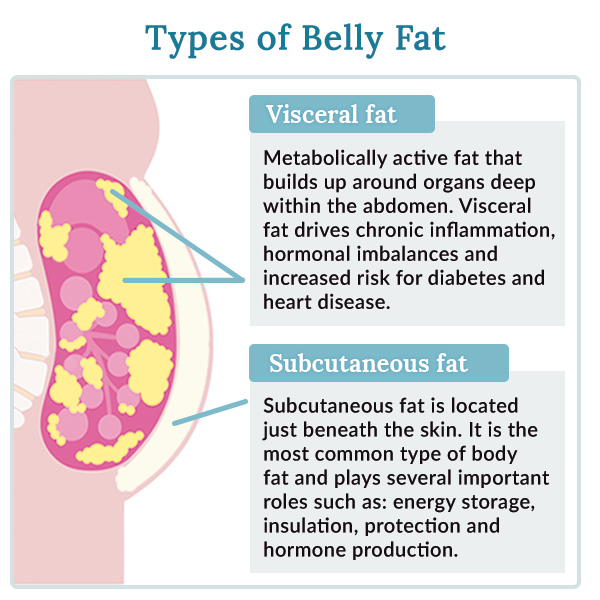Authored by Dr. Sarika Arora, MD
Let’s be honest. Over the last few decades, American women have built up a lot of belly fat. So it’s ironic that as our weight has grown, and our shapes have shifted, our understanding of what causes belly fat – and how to lose it for good – is stuck in the past.

It’s time for a new conversation. And not about Ozempic, or your old skinny jeans – but about your biology and the underlying causes of belly fat. Understanding the deeper health and hormonal factors behind it can help you finally release this weight for good.
The two kinds of belly fat, and what they tell us
What we call belly fat is actually two distinct types of fat – and each behaves very differently in your body.
- Subcutaneous fat is the soft, jiggly fat just under your skin that also tends to accumulate in areas like the thighs, hips and backs of your arms.
- Visceral fat is fat that builds up deep within the abdominal cavity, surrounding vital organs like the stomach, liver and intestines.
If you carry visible weight around your midsection, it’s a strong indicator that you have hidden visceral fat.
Why visceral belly fat is the real problem
If you’re overweight, odds are that most of the extra pounds around your middle are subcutaneous fat. Studies estimate that 80% of belly fat is subcutaneous and 20% is visceral.

This 20% visceral fat is enough to create lots of trouble for your health. That’s because visceral fat is metabolically active, meaning that it behaves like an endocrine gland, releasing hormones and inflammatory chemicals that disrupt nearly every system in your body.
Here are some of the documented risks associated with excess visceral belly fat:
- It increases inflammation.
Visceral fat pumps out inflammatory cytokines that drive chronic, low-grade inflammation — a silent contributor to many long-term health issues. - It disrupts your estrogen balance.
Visceral belly fat produces estrone, a weak form of estrogen that can fuel estrogen dominance. It also interferes with estrogen metabolism, throwing your hormones off balance and encouraging even more belly fat to accumulate. - It raises your risk for insulin resistance and type 2 diabetes.
Visceral fat messes with how your body processes insulin, paving the way for insulin resistance and, over time, diabetes. - It promotes heart disease.
Visceral fat is linked to higher LDL (“bad”) cholesterol and triglycerides, while lowering your HDL (“good”) cholesterol, increasing risk for cardiovascular disease. - It burdens your liver.
Excess visceral belly fat is linked to non-alcoholic fatty liver disease (NAFLD), which impacts your liver’s ability to filter toxins and regulate metabolism. - It impacts brain health.
The inflammation and hormonal shifts associated with belly fat speed up cognitive decline and raise your risk for dementia and Alzheimer’s disease. - It worsens Metabolic Syndrome.
Visceral fat plays a central role in this dangerous cluster of symptoms — high blood pressure, high blood sugar and abnormal cholesterol levels — all of which drastically increase your risk of heart attack and stroke. - It increases your risk of certain cancers.
Belly fat is strongly linked to breast and colorectal cancers.
As growing research continues to show, visceral belly fat is anything but harmless — it’s active, disruptive and related to serious health concerns.
Subcutaneous belly fat is less harmful, but not harmless
Subcutaneous belly fat – the kind that sits just under the skin – may not carry the same level of risk as visceral fat, but it’s not entirely innocent either. We need some subcutaneous fat to cushion and protect the body, but when it builds up in excess, it can quietly fuel low-grade inflammation and hormonal imbalances. Over time, these disruptions throw off your metabolism, drain your energy and compound the health risks already set in motion by visceral fat. Studies link excess subcutaneous belly fat to insulin resistance and type 2 diabetes, as well as imbalances in estrogen, leptin and other key hormones that influence how your body stores fat and regulates appetite.
Carrying a lot of subcutaneous belly fat can also affect how you move and feel each day. Emotionally, excess belly fat can take a toll on women’s self-esteem and become yet another source of stress – which only worsens the issue, since chronic stress sends powerful fat-storage signals. Physically, midsection weight gain puts strain on the joints and lower back, making it harder to stay active and comfortable. That’s why excess subcutaneous belly fat is considered a contributing factor to conditions like osteoarthritis.
But understanding what visceral and subcutaneous fat do in the body is only part of the story. To finally understand how to lose it, we also need to understand how this fat got there in the first place.
Belly fat isn’t about lack of willpower. It’s about biology
Once you understand the real health risks of belly fat, it’s natural to want it gone — fast. So you try everything: low-fat diets, calorie restriction, hours of cardio and every “belly fat-burning” hack in the book. But despite your best efforts, that stubborn fat around your middle refuses to budge.
Here’s the truth: the problem isn’t your willpower. Excess belly fat is a biological signal that your body has slipped into unhealthy homeostasis, a state in which your internal systems meant to maintain balance – including metabolism, stress response, blood sugar control and hormone signaling – have gone off track and gotten stuck there.
Think of your body like a thermostat designed to maintain a comfortable internal climate. In a healthy state, this thermostat keeps things running smoothly, supporting your energy, resilience and fat metabolism. But when chronic stress, poor diet, sleep problems or hormonal shifts disrupt that balance, it’s as if the thermostat gets jammed on the wrong setting. Your body starts to adjust to this new normal, holding onto fat — especially belly fat — “just in case.”
This is why belly fat is so hard to lose. Your body isn’t just ignoring your efforts, it’s actively working against them, staying stuck in fat-storage mode. And remember, visceral belly fat is metabolically active, releasing inflammatory signals, disrupting hormones and further worsening the problems that got you to this point.
So what’s the real cause of your belly fat? The same issues that broke your internal balance in the first place:
- Chronic stress and elevated cortisol
- Blood sugar instability and insulin resistance
- Hormonal imbalances during perimenopause and menopause
- Highly processed, nutrient-poor diets
- Poor sleep
- Thyroid dysfunction or other underlying metabolic issues
This is why losing belly fat isn’t a matter of willpower — and why trying harder won’t work. Instead, the key is to gently reset your body’s internal systems and guide it back to a state of healthy homeostasis, where fat burning is natural again and your body finally feels safe releasing this excess weight.
How to lose belly fat — the right way
It’s actually quite simple. Reducing belly fat starts with rebuilding internal balance through nourishing food, smart movement, stress relief and natural support. When your body starts to return to a healthy homeostasis again, it will begin to let go of the fat it no longer needs.
Here’s how to start:
1. Berberine helps your body boost GLP-1 — and target belly fat naturally
Berberine, a powerful plant compound found in barberry, goldenseal, and Oregon grape, works with your body’s own biology to increase natural GLP-1 levels — the same hormone that helps regulate appetite, stabilize blood sugar, and promote fat loss. When GLP-1 rises naturally, your metabolism shifts out of “fat-storage mode,” helping your body burn more fat for energy — especially the deep visceral belly fat that’s most resistant to change.
In clinical trials, women taking berberine saw meaningful reductions in visceral belly fat, triglycerides, and inflammatory markers — key indicators of improved metabolic health. For optimal results, berberine works best when paired with Inositol, a natural compound that supports insulin signaling and enhances GLP-1 responsiveness. (Our Weight BioType #1 is also forumulated Berberine, highly absorbably Myo=D-Chiro Inositol along with antixoidant-rich Super C Plus to reduce oxidative stress that can block metabolic pathways).
2. Keep blood sugar in balance
Unstable blood sugar is one of the biggest drivers of belly fat. When your blood sugar spikes and crashes, your body releases more insulin to manage it. Over time, this can lead to insulin resistance, where excess glucose gets stored as fat, especially around your belly. These swings also stress your system, disrupt hormones and trigger cravings – keeping your body locked in fat storage mode.
To shift your body back into balance:
- Eat protein with every meal (try eggs, Greek yogurt, poultry or lentils)
- Include healthy fats like avocado, olive oil, nuts and fatty fish
- Choose fiber-rich carbs like beans, berries and sweet potatoes
- Avoid processed foods, including refined sugars and inflammatory seed oils
Stabilizing blood sugar is one of the most powerful things you can do to return to healthy homeostasis and lose belly fat. For added support, learn more about our Blood Sugar Balance formula which includes clinically studied plant compounds and minerals like gymnema and chromium to help restore healthy blood sugar metabolism, improve insulin sensitivity and support your return to a more balanced, fat-burning state.
3. Lower stress and cortisol naturally
When you’re under chronic stress, your body releases high levels of the hormone cortisol — and that has a direct impact on belly fat. Cortisol signals your body to store energy in case of emergency, often in the form of visceral fat around your abdomen. Visceral fat cells in the belly have more cortisol receptors than other fat cells, making them especially responsive to stress. Over time, elevated cortisol not only increases fat storage but also slows down fat burning, disrupts blood sugar balance and throws off other key hormones, all of which make it harder to lose weight.
Skipping meals, overexercising or drastically cutting calories can backfire when you’re trying to lose belly fat. These stress-inducing habits spike cortisol levels, keeping the vicious belly fat–stress cycle going strong.
To bring cortisol back into balance:
- Practice calming activities daily, including meditation, breathwork, yoga or mindful walks.
- Lower excess cortisol levels with L-theanine and passion flower. Serinisol, our natural cortisol-lowering supplement, is formulated with both.
- Try magnesium to support stress resilience and insulin sensitivity.
- Re-regulate cortisol production with adaptogenic herbs like rhodiola and ginseng, both contained in our stress supplement Adaptisol.
When your stress response is healed, your body will stop clinging to excess fat for protection.
4. Eat in a way that respects your rhythm
There’s good evidence that gentle intermittent fasting (eating within an 8- to 10-hour window) may help reduce inflammation and support insulin balance. But it’s not ideal for everyone. If you’re under high stress, fasting is another stressor, which can backfire and spike cortisol. Listen to your body. If fasting leaves you drained, focus on steady nourishment instead.
5. Exercise to build strength — not burnout
Exercise is essential for restoring healthy homeostasis and supporting long-term fat loss — but not all movement has the same effect. High-intensity workouts can spike cortisol, especially if your system is already under stress, making belly fat even harder to lose. The most effective approach is movement that restores and strengthens your body without overwhelming it:
- Brisk walking supports heart health and stress regulation.
- Resistance training helps build lean muscle, boost metabolism and improve insulin sensitivity.
- Yoga and low-impact interval training offer a gentle way to build strength and reduce stress.
Many women also find that core-focused exercise like Pilates improves posture, tones the midsection, and supports the back — without pushing the body into cortisol overdrive.
6. Special help for “meno belly”
Hormonal imbalances that develop during perimenopause and menopause can make it harder to lose and easier to gain. The good news? Growing research shows that specific herbs and plant compounds effectively support the body’s ability to restore hormonal balance naturally – without the risks of synthetic hormone therapy.
If your belly fat started showing up around the same time as your hot flashes, that’s a strong sign it’s linked to a hormonal imbalance. To harness the power of herbs, our exclusive Herbal Equilibrium formula combines black cohosh, red clover, kudzu and other clinically studied herbs to gently rebalance hormones, ease frustrating symptoms like hot flashes and irritability, and support a healthier metabolism to help your body release stubborn belly fat.
You’ll be happier, not just skinnier
Losing belly fat isn’t about punishing your body. It’s about learning to listen to your body and taking the right steps to support it.
When you work with your biology – not against it – everything changes. You reclaim your energy, restore your hormones and reduce your long-term risk for disease.
And yes, you lose the belly fat, both subcutaneous and visceral. But even more importantly, you feel better in your body – from the inside out!
















